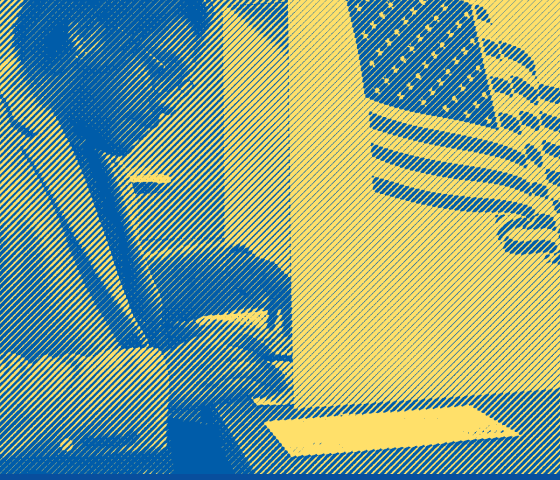Introduction1
According to the U.S. Department of Education, our nation’s schools are experiencing elevated rates of school-related arrests and referrals to law enforcement.2 Expert research has connected the presence of armed police officers in schools with these elevated rates3, creating criminal records that follow students around for the rest of their lives and make lifelong access to housing, employment, and social services much more difficult.
In Iowa in 2017-2018, nearly 1 in 5 secondary4 public schools reported having sworn law enforcement officers onsite.5
Iowa School-Related Arrest Rates6
According to the most recently available Civil Rights Data Collection data (2017-18), Black students, Latinx7 students, and students with disabilities8 in Iowa were subject to school-related arrests at disparate rates compared to their white and non-disabled peers. In our state:
- Black students were arrested at 7.79 times the rate of white students, the 3rd worst discrepancy rate between Black and white student arrests in the country10
- Latinx students were arrested at 1.9 times the rate of white students
- Students with disabilities were arrested at 3 times the rate of students without disabilities
| Black students | Latinx students | White students | Students with disabilities | Students without disabilities | |
|---|---|---|---|---|---|
| Number of students arrested | 293 | 129 | 466 | 281 | 682 |
| Arrest rate per 100,000 students11 | 936.9 | 236.2 | 121.3 | 456.7 | 153.4 |
Iowa School-Related Referrals to Law Enforcement12:
As with arrests, Black students, Latinx students, and students with disabilities were referred to law enforcement at disparate rates in Iowa compared to their white and non-disabled peers according to the most recently available CRDC data (2017-18). In our state:
- Black students were referred to law enforcement at 5 times the rate of white students, the 3rd worst discrepancy rate between Black and white student referrals in the country
- Latinx students were referred to law enforcement at 1.8 times the rate of white students
- Students with disabilities were referred to law enforcement at 2.8 times the rate of students without disabilities
| Black students | Latinx students | White students | Students with disabilities | Students without disabilities | |
|---|---|---|---|---|---|
| Number of students referred to law enforcement | 536 | 325 | 1,305 | 653 | 1,676 |
| Referral rate per 100,000 students | 1,713.9 | 595.0 | 339.7 | 1,061.3 | 376.9 |
Iowa School Support Professional Ratios
Expert organizations recommend a certain staff-to-student ratio to ensure students receive sufficient support and resources. Iowa does not meet these recommended ratios for school-based counselors, social workers, or psychologists.
| School support professional type | Recommended professional-to-student ratio | Iowa professional-to-student ratio |
|---|---|---|
| School counselors | 1:25013 | 1:37014 |
| School social workers | 1:25015 | 1:2,68216 |
| School psychologists | 1:50017 | 1:1,55318 |
- This document relies heavily on the U.S. Department of Education, Office for Civil Rights, Civil Rights Data Collection (CRDC), 2017-18. This data is reported by public school agencies (districts, charters, vocation-tech schools) to the U.S. Department of Education. https://ocrdata.ed.gov/. The ACLU of Iowa recognizes both the limitations of this dataset due to its age and challenges inherent in self-reported data. The CRDC remains the most recent and comprehensive dataset for the national school policing landscape despite these limitations, particularly due to lack of data collection during the COVID-19 pandemic. This document serves as an Iowa-specific data update to the national ACLU’s "Cops and No Counselors" report, which utilized CRDC data from 2015-16, https://www.aclu.org/report/cops-and-no-counselors.
- U.S. Department of Education, Office for Civil Rights, Civil Rights Data Collection, 2017-18, https://www2.ed.gov/about/offices/list/ocr/docs/crdc-exclusionary-school....
- Research on the Impact of School Policing, End Zero Tolerance, https://www.endzerotolerance.org/impact-of-school-policing,
- Secondary schools defined as 5-8, 6-8, 7-9, 6-12, 9-12, 10-12, and 9th grade academies to align with UCLA Center for Civil Rights Remedies. definition, https://schooldisciplinedata.org/ccrr/docs/Final_Disabling_Inequity_Repo....
- Calculated using U.S. Department of Education, Office for Civil Rights, Civil Rights Data Collection, 2017-18, Public Use File. This data is reported by public school agencies (districts, charters, vocation-tech schools) to the U.S. Department of Education, https://ocrdata.ed.gov/.
- “School-related arrest” refers to an arrest of a student for any activity conducted on school grounds, during off-campus school activities (in-person or virtual), while taking school transportation, or due to a referral by any school official. All school-related arrests are considered referrals to law enforcement, https://crdc.communities.ed.gov/#communities/pdc/documents/17270.
- “Latinx students” refers to students classified as “Hispanic or Latino of any race” by the U.S. Department of Education, Office for Civil Rights, Civil Rights Data Collection.
- “Students with disabilities” refers to students receiving Individuals with Disabilities Education Act (IDEA) services.
- All data calculations in this document are rounded to the nearest tenth (0.1).
- Compared with all 50 states, Puerto Rico, and Washington, D.C. National ratings are based on arrest and referral rates per 100,000 students, not hard numbers of arrests and referrals.
- Calculating the arrest rate per 100,000 students allows more intuitive comparison between demographic groups, even if those groups differ in size (for example, if there are significantly more students without disabilities enrolled in Iowa schools than students with disabilities).
- A "referral" occurs when a school employee reports a student to any law enforcement agency or officer, including a school police officer or security staff member for an incident that happens at school, during a school-related event, or while taking school transportation, regardless of whether official action is taken. All arrests are referrals. But not all referrals lead to arrests, https://crdc.communities.ed.gov/#communities/pdc/documents/17270.
- American School Counselor Association, https://schoolcounselor.org/About-School-Counseling/School-Counselor-Rol....
- American School Counselor Association, 2020-21 school year, https://schoolcounselor.org/getmedia/238f136e-ec52-4bf2-94b6-f24c3944702....
- School Social Work Association of America, https://www.sswaa.org/ssw-model.
- Calculated by dividing reported student enrollment (544,888) by reported number of FTE social workers (192), Iowa Department of Education, 2021 Condition of Education Annual Report, https://educateiowa.gov/sites/default/files/documents/2021ConditionOfEdu....
- National Association of School Psychologists, https://www.nasponline.org/research-and-policy/policy-priorities/critica....
- National Association of School Psychologists, 2020-21 school year, https://www.nasponline.org/about-school-psychology/state-shortages-data-....
